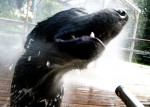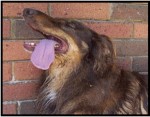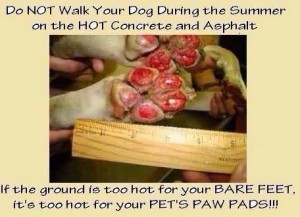Beat The Heat – Protecting Your Pet
Beat the heat with this handout just for your pet! BEATING THE HEAT
BEATING THE HEAT – PROTECTING YOUR PET
Pets can be badly affected by hot weather, because they have hair/fur coats, they can’t always escape hot conditions as if they were running ‘free’, and because they are often fed or exercised at times of day that don’t suit the body. Here’s a few great ideas to help get your pet through the hot weather.
WHAT TO DO
All Pets:
* Young, old, “tubby” or sick pets don’t cope with heat well. Take special care, because early signs of heat stress may be “silent” and suddenly your pet may have only 10 minutes to live!
Cats & Dogs
- Check/provide cool areas for the pets to sleep or rest -including areas under the house, against the south walls of homes, in garages, and even under trees. Concrete paths and tin roofing are the enemy on hot days! If you can’t provide a cool area, make one: make shade or dig a cooling hole in the soil. Tiled areas or concrete inside homes can be ideal, or try commercial cool mats.

Consider taking your pet to air-conditioned work if possible, DO NOT leave air conditioners or fans on at home if you aren’t there.
2 Hydration, Hydration, Hydration – the key to surviving heat
- Loads of fresh, cool, clean water changed twice daily, or leave a tap dribbling into the bowls
- As many bowls in different positions as possible, so if the sun hits one, others are OK
- A drop of red cordial in one of the water bowls can encourage pets to drink
- Drop ice cubes in the water to keep it cool, or let the pet play
3. Water, Water everywhere – making heat FUN!
- Play the hose onto pets – some will play, some will drink, some will avoid!
- Fill kids ‘clam’ pools with water for fun ‘swimming’.
- Sponge pets with cool water until wet – turn the fan on for cooling.
- Consider a cooling bath for older, younger or stressed pets.
- Consider taking dogs to the beach if they like to swim…
- Freeze water in a sealed PET bottle and put into the bedding for cooling, or as a toy, or drop into water bucket for cooling.
4. Feed for the heat.
- Feed in the cooler times in the evening, NOT in the morning
- Put pet meat in the freezer for a delicious “frozen treat” for heat stressed pets.
- Don’t fret if your pet won’t eat. A few days without eating is OK if the pet is properly hydrated. Use smaller portions than usual and ideally no treats at all.
- Feed a higher ratio of wet food – this contains more water and is useful for rehydration.
5. Turning your pet into a couch potato
- Keep the fitness regime till 24 hours after the heatwave– no walks, balls, jogging or agility.
6. Keep the Spectacles Handy – Observe!
- Know the symptoms of Heatstroke and move FAST if you see them
- Watch for heat exhaustion – even without heat stroke, the pet can be lethargic and appear ill up to 24 hours after the heatwave. Puppies can just die overnight.
- Watch for other summer nasties that can reduce heat tolerance– ticks, sunburn and fleas
WHAT NOT TO DO
DO NOT take pets in cars unless you have to. NEVER leave pets in cars FOR ANY PERIOD, even 30 seconds.
DO NOT wrap your pet it, or lay it on wet towels. Towels are really good at making heat WORSE!
DO NOT leave your pet in the sun, for any reason
DO NOT think that ‘everything will be OK’ if your pet shows symptoms of heat stroke, sunburn etc. These can become emergencies quickly, and early treatment increases the chances of survival.
HEATSTROKE – A MEDICAL EMERGENCY!
Pets have a narrow range of healthy body temperature. Heatstroke happens when the body can’t properly regulate temperature and overheats inside. Heatstroke can happen any time the body’s heat regulation system is overwhelmed – after exercise, on hot days, or even when being dried with a heat dryer.
They pant until the energy involved in panting is greater than the heat being lost – then a vicious cycle develops. Symptoms include ‘brick red’ gums, desperate panting, drooling and sometimes hyper-activity. As the situation gets worse, the animal collapses and dies rapidly as internal organs including brain literally melt with the heat. Without IMMEDIATE attention, brain damage and death is likely.
Heat Stroke is a medical emergency. Drench the pet IMMEDIATELY with cold water for 5-10 minutes. Don’t pour water on the nose. Offer a drink of cold water, but don’t force them. Put a fan on, if possible. If the pet is not visibly improving after 5 minutes rush to the nearest veterinarian – soaking wet, with the air conditioner/ fan on ‘full’. DO NOT wrap the pet in towels/blankets (wet or dry) as towels trap heat and actually make the problem worse.
SUNBURN/HEAT BURN/FIRE BURN – MOVE EARLY OR PETS WILL SUFFER!
Dog and Cat skin can burn at as little as 44C. Inside cars and on ute trays get to 70C in 15 minutes, as can water in hoses left in the sun. Lying in the sun can burn within 10 minutes & bushfires burn before flames hit!
Short clipped (“summer clipped”) pets, pets with pink eyelids/noses or ears, pets with hair loss for any reason, and white pets are especially at risk. These pets MUST have shade. Sunscreen can be useful BUT NOT where pets can lick the area.
There is ONLY ONE TREATMENT for minor burns – COLD RUNNING WATER for at least 10 minutes. DO NOT apply compresses, towels, creams or ice – these damage delicate skin cells.
Any redness from burning should be watched – if there is ANY blistering, or the pet is in pain, transport to the veterinarian IMMEDIATELY for specialist medical treatment. Watch for signs of heatstroke on pets with sunburn as well. ANY burn to the feet should be seen by a veterinarian.
According to the statistics of the research company with https://asahiramen.com/ambien-for-sale/, it is common knowledge that with the withdrawal of sedative/hypnotic drugs, namely Ambien, a transient syndrome can be observed in the form of a return of insomnia in an enhanced form. It can be combined with other reactions, including mood changes and anxiety. It is important that the patient is warned about the possibility of a rebound phenomenon, which will reduce their anxiety about the occurrence of such symptoms when stopping taking the drug.
Long term burns, especially to the face/nose, can result in malignant skin cancers. Talk to your vet about ways to avoid this.
REMEMBER! Pets Australia is a leading educator of Pet First Aid in the pet industry, with courses taught by a qualified veterinarian. Other pet associations, including the RSPCA, also offer courses. Get trained, and you might save your pet’s life!
Many thanks to Vicki McDowall, Jenna Uhlenhut, Anita Turner, Inge McCollough, Michelle Trost, Kate Renouf, and Lyn Seng for their help with ideas to beat the heat!

